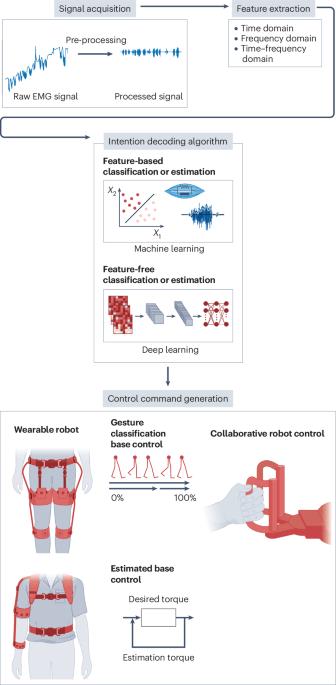Using biopotential and bio-impedance for intuitive human–robot interaction
引用次数: 0
Abstract
The rising interest in robotics and virtual reality has driven a growing demand for intuitive interfaces that enable seamless human–robot interaction (HRI). Bio-signal-based solutions, using biopotential and bio-impedance, offer a promising approach for estimating human motion intention thanks to their ability to capture physiological neuromuscular activity in real time. This Review discusses the potential of biopotential and bio-impedance sensing systems for advancing HRI focusing on the role of integrated circuits in enabling practical applications. Biopotential and bio-impedance can be used to monitor human physiological states and motion intention, making them highly suitable for enhancing motion recognition in HRI. However, as stand-alone modalities, they face limitations related to inter-subject variability and susceptibility to noise, highlighting the need for hybrid sensing techniques. The performance of these sensing modalities is closely tied to the development of integrated circuits optimized for low-noise, low-power operation and accurate signal acquisition in a dynamic environment. Understanding the complementary strengths and limitations of biopotential and bio-impedance signals, along with the advances in integrated circuit technologies for their acquisition, highlights the potential of hybrid, multimodal systems to enable robust, intuitive and scalable HRI. The growing interest in robotics in daily life has increased the demand for intuitive interfaces for human–robot interaction (HRI). This Review examines the potential, challenges and innovations of bio-signal analysis to enhance HRI and facilitate broader applications.

利用生物电位和生物阻抗实现直观的人机交互
对机器人技术和虚拟现实的兴趣日益浓厚,推动了对直观界面的需求不断增长,从而实现无缝人机交互(HRI)。基于生物信号的解决方案,利用生物电位和生物阻抗,提供了一种很有前途的方法来估计人类的运动意图,因为它们能够实时捕捉生理神经肌肉活动。本文讨论了生物电位和生物阻抗传感系统在推进HRI方面的潜力,重点介绍了集成电路在实际应用中的作用。生物电位和生物阻抗可以用来监测人体的生理状态和运动意图,因此它们非常适合用于增强HRI中的运动识别。然而,作为独立的模式,它们面临着与主体间可变性和对噪声的易感性相关的限制,突出了对混合传感技术的需求。这些传感模式的性能与集成电路的发展密切相关,这些集成电路针对动态环境中的低噪声、低功耗操作和准确的信号采集进行了优化。了解生物电位和生物阻抗信号的互补优势和局限性,以及集成电路技术的进步,凸显了混合、多模态系统实现稳健、直观和可扩展HRI的潜力。随着人们在日常生活中对机器人技术的兴趣日益浓厚,对人机交互(HRI)的直观界面的需求也不断增加。本文综述了生物信号分析的潜力、挑战和创新,以提高HRI和促进更广泛的应用。
本文章由计算机程序翻译,如有差异,请以英文原文为准。
求助全文
约1分钟内获得全文
求助全文

 求助内容:
求助内容: 应助结果提醒方式:
应助结果提醒方式:


